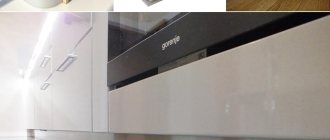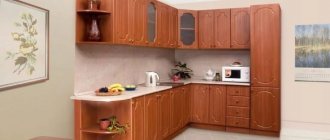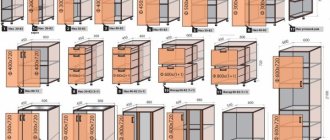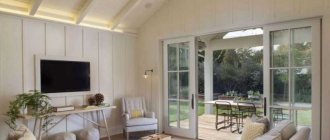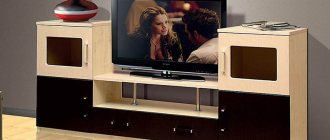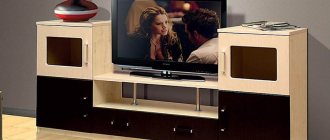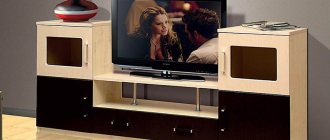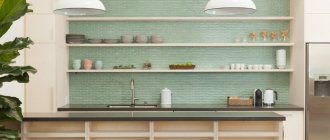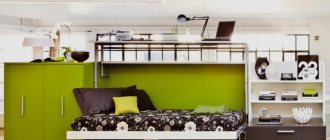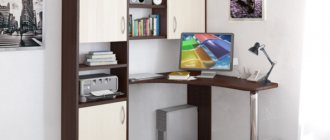It would seem that insignificant details often determine whether the furniture will be comfortable and durable or not. Choosing and installing the right legs for a kitchen unit is not as easy as it seems at first glance. Delving deeper into this question, it turns out that they are very different from each other: high and low, adjustable and not, plastic and metal... So which are better, and are they needed at all?
Advantages and disadvantages
There are no advantages without disadvantages, but kitchen legs have many more advantages than disadvantages.
The positive points include:
- aesthetic appearance. Furniture with legs looks lighter and airier. This point is especially important in small kitchens;
- extra space. It is very convenient to store bulky items under the kitchen unit: building materials left over after renovation (cuts of skirting boards, profile pipes), skis, etc. The main thing is to push items away so as not to spoil the appearance of the kitchen;
- headset protection. Legs save the lower cabinets and their contents in case of a flood. In most cases, supports are made of materials inert to water (plastic, metal). Therefore, when flooding occurs, only the flooring suffers, and not the furniture;
- ease of adjustment. During installation, height-adjustable legs make it very convenient to level the tabletop. With their help, you can smooth out differences caused by floor defects;
- free access to communications;
- additional ventilation. It is especially important if the kitchen has built-in appliances;
- Possibility to fix the plinth . The presence of legs allows you to remove and install the base if necessary. With its help you can change the appearance of the kitchen.
There are significantly fewer negative aspects. The main disadvantages can be considered:
- difficulties with cleaning. You can only get rid of dust and dirt around each support manually, which is tiring. But if this is not done, cobwebs and debris peeking out from under the headset will spoil the appearance of the interior;
- objects rolling into the gap between the set and the floor. During the cooking process, any fallen round-shaped vegetable (onions, potatoes, etc.) will certainly end up under the kitchen cabinets. If there are animals or small children in the house, there will be many times more unnecessary items under the set. Without noticing in time an apple that has rolled under the cupboard, after a while you can find a lump of rot and mold there;
- higher cost. No, standard plastic supports are relatively inexpensive, but they do not have a very aesthetic appearance. They are usually hidden by additionally installing a base. Designer legs made of metal or wood cost many times more.
Most manufacturers of high-quality furniture make it with legs. Only budget models of headsets of not very high quality are produced on a non-removable base (a box made of MDF or chipboard). Such a support swells very quickly from moisture and loses its appearance. Even the silicone base covers (covers) that are sold to protect the box do not help.
Kinds
Furniture legs whose height can be adjusted are more convenient to use than non-adjustable products. They have wider functionality than non-adjustable products, as they allow you to eliminate uneven floor coverings by installing furniture at the height that suits family members.
By shape
Adjustable furniture legs are manufactured today for a variety of designs, come in different shapes and have specific operational parameters. With the help of such devices, the product stands firmly on the base, does not wobble, looks holistic, concise, and attractive. They are highly resistant to impact, strong, durable, and practical. This is important to understand when selecting such products for your home.
Many furniture stores offer furniture legs of different shapes. Let us describe their operational parameters below:
- single elements - straight, curved, roller (reminiscent of a wheel in shape), shaped supports;
- folding models - used mainly for transformable tables. Such products are compact in size when folded, so the table itself does not take up much free space, which is very important in small apartments.
To size
You should not think that the design of such structures is limited to a few shapes and a couple of color schemes. Today, manufacturers delight customers with a huge number of furniture legs of various shapes with the ability to adjust the height of the product. We will describe them further.
The adjusting mechanism of furniture supports allows you to choose the installation height of a furniture set, cabinet or cabinet at your discretion. This is extremely important if there are floor deviations from the horizontal.
Based on size, such products are divided into several groups:
- low - such a product has a height of 50-60 mm and is used for such pieces of furniture as cabinets, coffee tables, kitchen units;
- medium - the height of the models ranges from 60 to 80 mm;
- high - have a height ranging from 80 to 850 mm. The highest options are used for tables. As a result, its surface is set at the optimal level for a person.
According to the material of manufacture
Today, furniture fittings manufacturers use three main materials and various combinations of them in their production process. For the manufacture of furniture supports, plastic, metal, wood are used:
- Metal legs visually look very beautiful and laconic. They are successfully combined with other metal parts of the kitchen unit, shelving, and wardrobe. Such products allow you to quickly update the external aesthetics of furniture, complementing it with a subtle style that is not flashy luxury. Models made of aluminum and chrome are in demand on the domestic market. Almost no negative factor present in a living space can spoil the appearance of a metal support;
- supports made of plastic do not look as catchy as those made of metal, but are characterized by wider variations in size and functionality. Such products are relevant for various types of kitchen furniture of different sizes and purposes. There are also wide color variations of plastic legs, but they do not last as long, because mechanical stress extremely spoils the aesthetics of the plastic surface;
- wooden - such designs are relevant for sofas, armchairs, dining groups in the kitchen. Wooden supports are decorated with carvings, turning them into a real work of furniture art. But natural wood has average resistance to moisture, so you should not allow wooden furniture legs that are adjustable in height to come into contact with water for a long time.
For furniture made of natural wood, you may prefer a combination of metal and wooden overlays, which in tandem perfectly imitate the aesthetics of wood, but retain high strength.
Wooden
Metal
Plastic
Varieties
The range of supports for kitchen units is very large. You can choose the right size, shape and color to suit any kitchen style. At the same time, kitchen legs can be distinguished according to several parameters.
Form
Modern designers offer an almost endless number of possible options: from the banal to the most non-standard. Conventional cylindrical supports are considered classics, but in addition to them there are:
- cubic;
- triangular;
- legs of irregular shape;
- trapezoidal;
- spherical;
- wavy;
- ovoid.
When choosing the shape of the legs for the set, you need to take into account the supports of the rest of the kitchen furniture. Manufacturers often produce components for tables, chairs, sofas, etc. in one collection. A single style of supports will be very beneficial to unite all the elements of furniture, making the interior whole and complete.
Types of furniture legs are not limited to the above options, but other types are practically not used for kitchen sets. The same wheeled models often cannot withstand the load, so they are used only in isolated cases.
Supports, legs for furniture
Material
Any of the forms can be embodied in various materials. The most common types:
- plastic. Quite a common material (due to its low cost). Both very simple models are produced (they are usually hidden behind the plinth), as well as more original designs “like wood” or “chrome”;
- from natural wood. They are rarely found on the open market due to their relatively high cost (the price of the simplest wooden legs starts at 500 rubles per unit, while a budget plastic support will be ten times cheaper). Usually they are made to order, complete with a similar set made of natural wood;
- metal. The most popular option. Most often they are made of aluminum, steel or their alloys. A huge selection of shapes and sizes allows you to choose an interesting option for almost any interior. But metal legs for lower cabinets look best in modern styles (modern, hi-tech, minimalism, etc.). As for the cost, it can vary greatly depending on the production method. Metal supports can be: pipe;
- cast;
- stamped;
- combined. Most often they combine metal with plastic, much less often with wood. In most cases, such models are made adjustable (the plastic knob is unscrewed with a screw).
Often, in order to reduce the cost of the headset, designer metal legs are installed only on the front (visible) part. Hidden supports are replaced with inexpensive plastic analogues. On a volumetric headset, using such a substitution you can save several thousand.
Dimensions. Adjustable and non-adjustable
Depending on the material and manufacturer, the supports are adjustable or non-adjustable. The latter are much more convenient; they allow you to change the height of furniture legs by a distance of 20 to 40 mm (depending on the manufacturer). This is very convenient if the floor covering has differences. With this adjustment, it is easy to level the countertop and cabinets, regardless of the slope of the floor.
Non-adjustable are available in three standard sizes:
- 10 cm;
- 12 cm;
- 15 cm.
If the floor is flat, then in most cases this set of values is sufficient. Plinth strips are produced to suit every standard height. But if there are unevenness and differences in the floor, it is better to give preference to adjustable kitchen supports.
Some models of plastic legs can be cut to the desired height. Theoretically, it is possible to trim supports made of solid wood or aluminum, but the final version in this case does not always look aesthetically pleasing.
Also, the legs can vary greatly in diameter or thickness. This point is also important. The thinner the support, the greater the load will fall on the point of contact between the support and the “floor” of the headset. If the lower base is made of not very strong materials, it may bend at the attachment points under the weight of the kitchen cabinets.
Color
Classic options are: black and metallic shades. Chrome legs come in matte and glossy finishes. In addition, they can imitate various metals with their shades. They come in colors like bronze, gold, silver, etc.
Solid wood supports are usually tinted to match the color of the set, in some cases they are made to contrast in tone with other finishing elements.
The choice of shades for plastic products is limited; usually they are only black, white or brown. This is due to the fact that in most cases they are hidden behind the base, or placed on the side of the rear (hidden) wall.
How to choose?
The main job of kitchen legs is to support the weight of lower cabinets and their contents. Therefore, the main selection criterion should be the reliability and strength of the support. Flimsy models with thin walls can shorten the life of the headset.
When purchasing kitchen legs, they must be checked for defects. There should be no cracks or places with thin soft metal or plastic (the wood is usually solid, so such problems arise less often with it). If the product can be bent by hand, it is unreliable.
Depending on the width of the supported module, a different number of supports are required:
- two. Suitable for narrow cabinets up to 20 cm wide;
- four. The most common option. Suitable for modules up to 80–90 cm wide. The maximum width depends on the depth of the cabinet and the expected load;
- six . Installed on large cabinets with a width of more than 90 cm.
As for the height of the supports, there are no strict regulations, rather wishes.
In kitchens with low ceilings, a set with high legs looks disproportionate. But when choosing the height of the supports, you must first focus on your own height.
It will be inconvenient for a tall person to cook on a low countertop, just as it will be inconvenient for a short person to cook on an excessively high one. Choosing the wrong height can lead to back problems.
Article on the topic: Height of kitchen tables with countertops. Optimal and standard sizes
If you don’t know exactly what height is needed, it’s better to give preference to adjustable legs. In most cases, a travel reserve of 20–40 mm is enough to adjust the overall height of the cabinet.
How to adjust
Experts say that the features of adjusting furniture supports come down to the type of furniture structure for which the fittings are used. Therefore, you need to carefully measure the parameters of the cabinet, table or cabinet, as well as their missing height. Such actions will allow you to determine the current height of the proposed piece of furniture, as well as understand what the design should be in the end.
Let us describe the comfortable height for various surfaces, depending on the fact what processes are performed on them:
- The sink is installed at a distance of one meter from the floor. Then it will be comfortable to use, and the human spine will not experience increased stress;
- the cooking area, work surfaces, and dining table will be as comfortable and safe as possible with a leg height of 85 cm;
- The height of the wardrobe with maximum capacity is 190, 210 cm from the floor.
The support, the height of which can be adjusted, is very convenient to use.
The support must be screwed into a nut fixed directly to the furniture body. To set the selected height, you will need to take a screwdriver and screw the screw into the mating part to the level that is selected as optimal.
How to screw it to furniture?
Various manufacturers literally compete in a variety of shapes and designs. But when choosing a non-standard solution, you should remember that the method of fastening will depend on the shape of the legs. Conventionally, all installation options can be divided into three types:
- standard. The most common installation method. Four fixation points (holes for fastening) are evenly distributed around the support;
- screw. Found near cylindrical and spherical supports. B with a thread that screws into the cabinet. The support has no other fixation points. Some models are supplied with a counter nut to screw the leg to the kitchen cabinet through the “floor”;
- non-standard. Models of non-standard shape are attached in this way. The installation option and the number of fixation points depend on the type of specific support. So, triangular legs have three fastening points, etc.
Most ready-made sets that only require self-assembly (from Ikea, etc.) have counters - small diameter holes in the places where the legs are supposed to be installed.
Screw-in legs are installed directly into the countersinks. Other models of supports are fixed so that this hole coincides with the center of the leg.
If the furniture was made to order, and there are no mounting holes for supports in the bottom cover, then you need to choose at what distance to attach the legs of the kitchen set based on three simple rules:
- the distance from the edges should be at least 5–8 cm;
- intermediate legs (if they are necessary) are attached under the transverse jumper (in the absence of one, in the center);
- on the side of the facade, the indentation should be such that the legs (or base) do not interfere with approaching the cabinets. The distance must be selected with special care if you have a dishwasher. If the indentation is incorrect, the plinth may subsequently interfere with opening the dishwasher door.
Next, on the bottom cover, markings are made for the legs in the form of crosses (the intersection of the lines should coincide with the center of the support). If there will be a lot of supports, it makes sense to make a template through which it will be convenient to put marks and make holes. In this case, you need to ensure that all supporting elements are at the same distance from the edge.
If the legs are fixed using self-tapping screws, then the length of the fastener should be 3 mm shorter than the thickness of the bottom cover. So, in order to properly screw the legs to a base 18 mm thick, you need 15 mm self-tapping screws.
⚫ How to screw LEGS TO KITCHEN CABINETS
Materials and style
The main parameter when choosing furniture legs is the material from which they are made.
Metal
This material is the most durable and durable. Legs made from it are stable and aesthetically attractive. Additional protection for the table is provided by rubber or plastic bearings. They are put on the racks and prevent furniture from slipping on the floor.
The most common materials for metal legs are round, rectangular and square pipes.
- Metal legs are most often made from round or profile pipes.
- Their cross section varies from 2.5 to 6 cm.
- The thickness of the pipe walls can be from 1.2 to 3 mm.
Table legs can be made from the following metals and alloys:
- aluminum;
- bronze;
- brass;
- black iron;
- stainless, nickel-plated or chrome-plated steel;
- cast iron
Chrome plated supports look elegant.
The color and texture of metal legs depend on the method of their processing and design. Based on these characteristics, supports can be:
- glossy;
- matte;
- chrome-plated, nickel-plated, polished;
- gold-plated, silver-plated or bronze-tinted;
- painted with enamel.
Forged racks are considered elite.
Regarding the style of furniture supports:
- Legs made of wrought iron or cast bronze, brass, cast iron are universal and fit harmoniously into almost all interior styles. They look elegant and rich.
- Models made of polished stainless steel, as well as chrome-plated and nickel-plated analogues, are most suitable for modern styles. This is minimalism, hi-tech, art deco, modern, steam punk.
- Simple aluminum or iron supports are good for country, loft, eco-style.
Wood
Most often the legs are made of wood.
Solid wood is the most common raw material for making furniture supports. This material is strong, durable, environmentally friendly and versatile. It blends harmoniously with all interior styles.
For the production of wooden legs, beams with a width of at least 50 mm are used.
Inexpensive supports are made from such types of wood:
- pine trees;
- poplars;
- ash;
- beech;
- hornbeam;
- birch, etc.
Oak stands will last as long as possible.
To produce elite models of tables, dense, hard and durable varieties belonging to valuable species are used:
- nut;
- Red tree;
- oak;
- yew;
- larch;
- ironwood;
- wenge, etc.
Wood is easy to process. Thanks to this, you can make supports for furniture of various shapes and designs. For example, carved legs are very valuable.
The wood is protected from moisture by paint.
To protect wood from external influences and improve aesthetic qualities, it is sanded. Then it is covered with 2-3 layers of coloring composition, tinted or transparent varnish.
Plastic
Plastic is the cheapest material for making a table.
The technology for producing plastic products has now greatly advanced. It makes it possible to produce products of a wide variety of qualities - from elastic and resilient to very hard and durable.
Here, for example, are the characteristics of polyurethane supports:
- These legs are comparable in strength to natural stone.
- Polyurethane is resistant to strong mechanical stress and vibration.
- The plasticity of the heated raw material makes it possible to give the table supports any shape. Even the look of carved wood.
- In appearance, plastic legs are in harmony with all types of lids and the surrounding environment in the room.
- The service life of the supports increases their resistance to water. This makes it possible to use them in damp rooms and outdoor conditions.
- Polyurethane is a non-flammable substance. Therefore, it will be an excellent choice for increased fire safety requirements.
Polyurethane legs are indistinguishable from turned wood.
It is worth warning that models of legs made of cheap plastic may disappoint you with their qualities. They are short-lived and less durable than analogues made from high-quality polyurethane or polypropylene.
For glass cover
The design of the supports for the glass lid should be special. After all, the transparent tabletop focuses attention on them.
Here are some examples of such legs:
| Photo | Type of supports for glass table top |
| The frame is made of a metal profile. It bends at an angle of 90˚ across the section. | |
| Forged supports Such openwork legs look rich and stylish. Forging can be solid or be a decorative element of the racks. | |
| Crossed legs They are made from square wooden blocks or metal pipes. The legs tilt at an angle and cross in the middle in the form of the letter “X” or “F”. |
Other materials
- Bamboo . This material will bring the spirit of Africa or Asia into the style of the room. The legs can either be woven from young bamboo or made from its whole stems.
- Willow twigs and rattan vine . Tables with wicker supports are usually purchased for cottages and country houses. Such supports bring the decor of the room closer to eco-style or country style.
- Glass . A table made entirely of this material looks aesthetically pleasing and original. Glass legs are optimal for rooms in which there are a lot of the same dishes. Such supports can be transparent or tinted.
Table made entirely of rattan.
Advantages of ready-made supports
- Durability . The reliability of the entire table structure is closely related to it.
- Sustainability . For furniture such as a table, this characteristic is especially important.
- Low cost . This parameter is valuable for users who make tables themselves.
- Durability . A long period of operation is the most significant advantage of the supports.
- Varied design . It increases the aesthetics of the legs.
How to adjust the height of the supports?
When installing the headset on adjustable legs, problems with adjustment usually do not arise. The height of the supports can be changed using a special screw thread.
With the help of adjustment, three issues can be solved at once:
- level the tabletop;
- distribute the weight of the kitchen cabinets evenly between all supporting elements;
- adjust the height of the tabletop in accordance with the height of the residents of the house.
Typically, the supports are adjusted during the initial assembly of furniture. If adjustments are needed during operation, the cabinets must be completely unloaded before adjustment.
You can change the height of non-adjustable legs only by cutting them, or, on the contrary, by placing something under the supports. Both methods cannot be called successful, but in some cases this is the only available solution.
How to choose legs for a kitchen set?
Any furniture is always installed on supports. And the kitchen set is no exception. Considering its dimensions and the amount of dishes it holds, you need to take the choice of legs quite seriously. After all, the foundation of the kitchen must be reliable in order to withstand heavy loads.
The second, no less important criterion for choosing furniture legs for a kitchen plinth is ease of installation and the ability to adjust. That is why height-adjustable structures are considered the most popular today.
Adjustable legs for kitchen set
They allow you to raise the base cabinet to a level that is comfortable for use or ideally match the level of the countertop with the image or with the line of the apron tiles.
If the leg is not covered by a base (as intended), then the external one is also important. Fortunately, there is quite a large selection of them on the market from different materials, different shapes and colors, so that there will be no problems with choosing the right style.
Standard height is 10 cm.
But if necessary, you can purchase legs for kitchen furniture 6, 12 or 15 cm long.
Adjustable ones can add 3-4 cm.
Do I need to cover the legs, and with what?
Beautiful designer legs are usually left open. They are initially selected to match the rest of the kitchen interior.
There are many advantages to this solution:
- lighter and airier look of the headset;
- availability of additional space for storing bulky items (narrow and long);
- additional ventilation (good air flow is especially important if there are built-in appliances).
Despite the large number of advantages, kitchens without a plinth on legs are not very common. This is due to a fairly large number of associated disadvantages:
- something is constantly being rolled under the set with open legs (food during the cooking process, children's toys, all sorts of little things);
- Thoroughly cleaning the space under kitchen cabinets with legs can only be done manually, and dust and dirt “peeping out” from under the furniture spoil the interior;
- higher price. Even the smallest set requires at least a dozen supporting elements. For large U-shaped or island kitchens you may need forty or fifty of them. Beautiful designer legs are usually quite expensive, and budget plastic ones don’t look very interesting.
Most often they are hidden by standard plastic supports. There are three ways to hide them:
- behind the plinth . This option is the most popular. The planks are produced from a variety of materials (plastic, MDF, aluminum chipboard, etc.) in various colors. In addition to decoration, the base can perform many additional functions: protect the space under the headset from dust and moisture (for this, a special silicone seal is placed on it);
- be an additional lighting element (for illumination, spotlights can be embedded in it, or an LED strip can be attached);
- be a functional part of the set (additional drawers are built into the base, thereby increasing the amount of usable space);
- behind the curtain. Curtains instead of kitchen facades are also not very common, but are still found in retro-style kitchens. This drapery successfully hides not only the shelves of the cabinets, but also the lower supports. In addition to the non-standard design, this solution helps to significantly save on facades and fittings, which do not need to be screwed to the kitchen cabinet.
Whether the bottom should be covered is a moot point. After all, both options have both advantages and disadvantages. Therefore, this decision is made for each case separately, taking into account all the features of the interior.
How to attach the plinth to the legs?
Special mounting clips are sold for mounting the base. They consist of two parts: one half is mounted on the protective strip, and the second is fixed on the leg.
It is most convenient to install clips on the most common plastic supports. In most cases, such supporting elements are sold immediately complete with fasteners for the base.
It is also possible to attach the base to metal or solid legs. But you will have to buy the clip separately, matching it to the shape and diameter of a particular model.
The bar is not attached to all supports of the headset. If kitchen cabinets are less than one and a half meters long, then two fixation points at the edges of the module are sufficient. Longer plinths require an additional attachment point closer to the middle of the strip.
The installation process of the support clip does not require any special skills. Marks are placed on the strip at the locations where the fasteners are installed. The clips are screwed to the bar using short self-tapping screws with flat heads (so that they do not penetrate through the base and interfere with the clip).
The second part of the clip is fixed to the kitchen support. In this case, you need to ensure that both parts of the fastener are at the same level.
It is quite easy to snap the base into place, but if you are not used to it, it may not work the first time. There is no need to worry about this; just a few attempts and attaching the base will seem like an elementary procedure.
For rooms of non-standard design, bent strips and special connectors have been developed. They allow you to assemble a plinth for L-shaped or trapezoidal kitchens.
Photo gallery
Did you like the article? Tell your friends about it:
- 1
- 1
- 1

